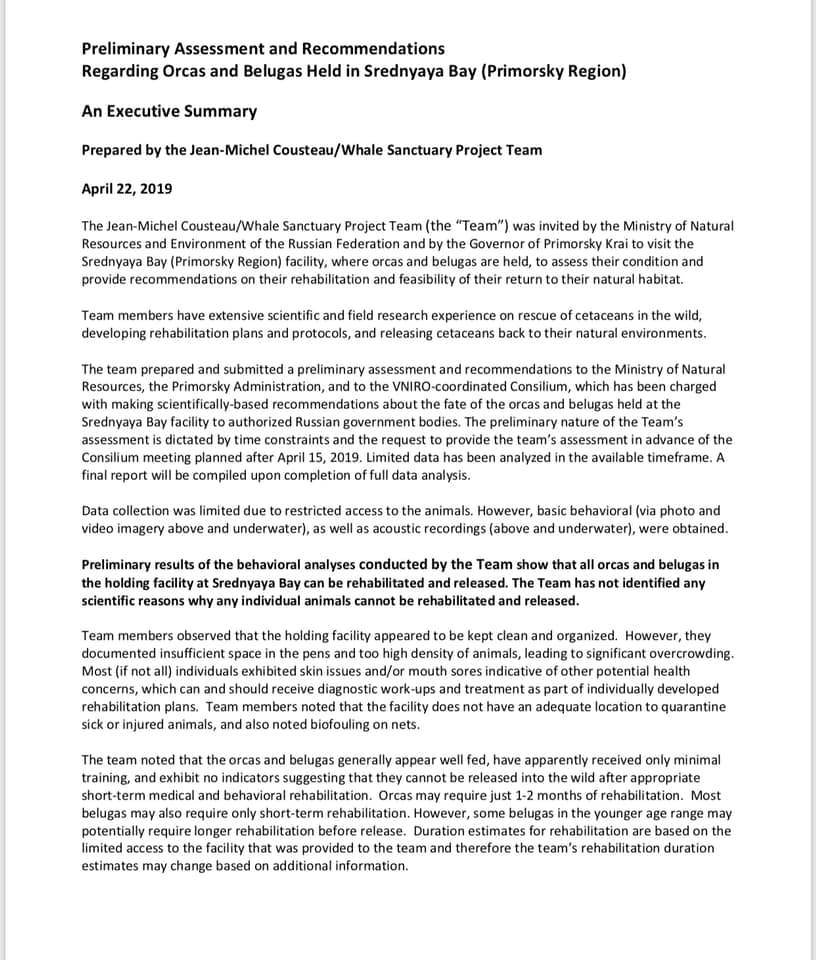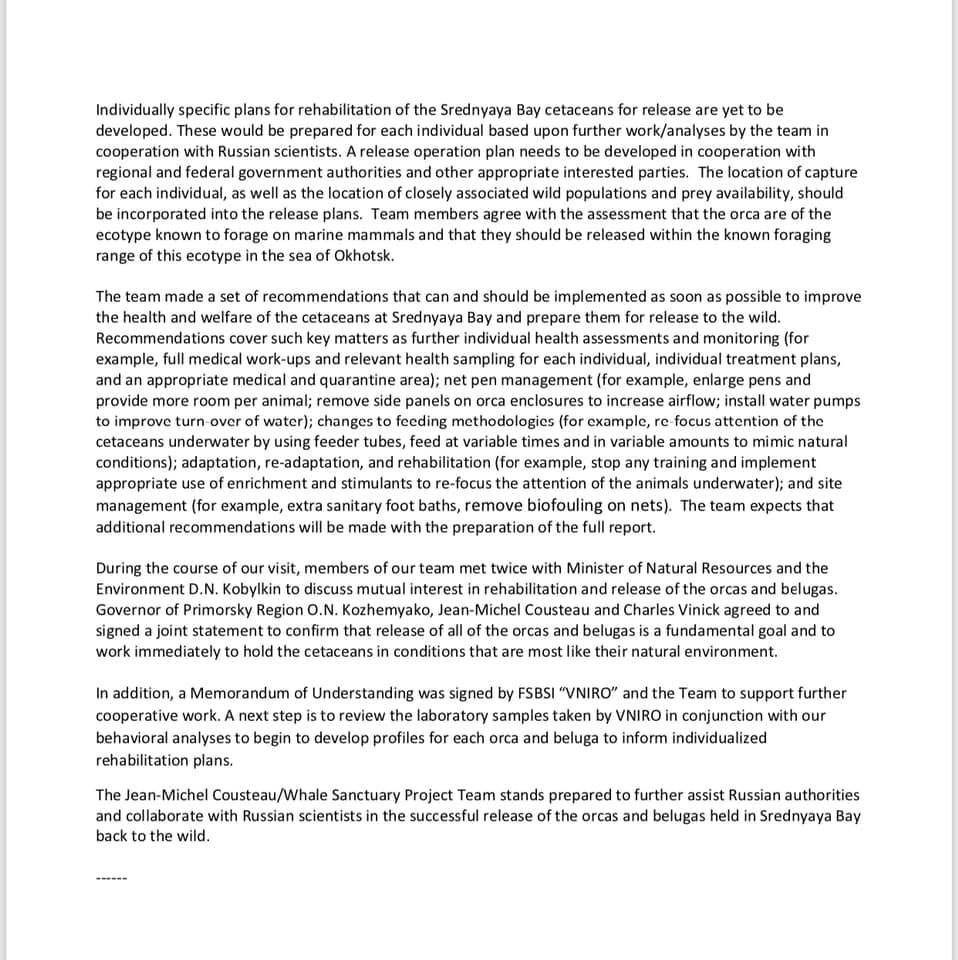All orca and beluga whales can be released
Cousteau Team report
13.05.2019Scientific concilium : “There are no contraindications for the release of orcas and belugas in their natural habitat”
13.05.2019All orca and beluga whales can be released
Preliminary Assessment and Recommendations
Regarding Orcas and Belugas Held in Srednyaya Bay (Primorsky Region)
An Executive Summary
Prepared by the Jean-Michel Cousteau/Whale Sanctuary Project Team April 22, 2019
The Jean-Michel Cousteau/Whale Sanctuary Project Team (the “Team”) was invited by the Ministry of Natural Resources and Environment of the Russian Federation and by the Governor of Primorsky Krai to visit the Srednyaya Bay (Primorsky Region) facility, where orcas and belugas are held, to assess their condition and provide recommendations on their rehabilitation and feasibility of their return to their natural habitat.
The team prepared and submitted a preliminary assessment and recommendations to the Ministry of Natural Resources, the Primorsky Administration, and to the VNIRO-coordinated Consilium, which has been charged with making scientifically-based recommendations about the fate of the orcas and belugas held at the Srednyaya Bay facility to authorized Russian government bodies. The preliminary nature of the Team’s assessment is dictated by time constraints and the request to provide the team’s assessment in advance of the Consilium meeting planned after April 15, 2019. Limited data has been analyzed in the available timeframe. A final report will be compiled upon completion of full data analysis.
Data collection was limited due to restricted access to the animals. However, basic behavioral (via photo and video imagery above and underwater), as well as acoustic recordings (above and underwater), were obtained.
Preliminary results of the behavioral analyses conducted by the Team show that all orcas and belugas in the holding facility at Srednyaya Bay can be rehabilitated and released. The Team has not identified any scientific reasons why any individual animals cannot be rehabilitated and released.
Team members observed that the holding facility appeared to be kept clean and organized. However, they documented insufficient space in the pens and too high density of animals, leading to significant overcrowding. Most (if not all) individuals exhibited skin issues and/or mouth sores indicative of other potential health concerns, which can and should receive diagnostic work-ups and treatment as part of individually developed rehabilitation plans. Team members noted that the facility does not have an adequate location to quarantine sick or injured animals, and also noted biofouling on nets.
The team noted that the orcas and belugas generally appear well fed, have apparently received only minimal training, and exhibit no indicators suggesting that they cannot be released into the wild after appropriate short-term medical and behavioral rehabilitation. Orcas may require just 1-2 months of rehabilitation. Most belugas may also require only short-term rehabilitation. However, some belugas in the younger age range may potentially require longer rehabilitation before release. Duration estimates for rehabilitation are based on the limited access to the facility that was provided to the team and therefore the team’s rehabilitation duration estimates may change based on additional information.
Team members have extensive scientific and field research experience on rescue of cetaceans in the wild, developing rehabilitation plans and protocols, and releasing cetaceans back to their natural environments.
Individually specific plans for rehabilitation of the Srednyaya Bay cetaceans for release are yet to be developed. These would be prepared for each individual based upon further work/analyses by the team in cooperation with Russian scientists. A release operation plan needs to be developed in cooperation with regional and federal government authorities and other appropriate interested parties. The location of capture for each individual, as well as the location of closely associated wild populations and prey availability, should be incorporated into the release plans. Team members agree with the assessment that the orca are of the ecotype known to forage on marine mammals and that they should be released within the known foraging range of this ecotype in the sea of Okhotsk.
The team made a set of recommendations that can and should be implemented as soon as possible to improve the health and welfare of the cetaceans at Srednyaya Bay and prepare them for release to the wild. Recommendations cover such key matters as further individual health assessments and monitoring (for example, full medical work-ups and relevant health sampling for each individual, individual treatment plans, and an appropriate medical and quarantine area); net pen management (for example, enlarge pens and provide more room per animal; remove side panels on orca enclosures to increase airflow; install water pumps to improve turn-over of water); changes to feeding methodologies (for example, re-focus attention of the cetaceans underwater by using feeder tubes, feed at variable times and in variable amounts to mimic natural conditions); adaptation, re-adaptation, and rehabilitation (for example, stop any training and implement appropriate use of enrichment and stimulants to re-focus the attention of the animals underwater); and site management (for example, extra sanitary foot baths, remove biofouling on nets). The team expects that additional recommendations will be made with the preparation of the full report.
During the course of our visit, members of our team met twice with Minister of Natural Resources and the Environment D.N. Kobylkin to discuss mutual interest in rehabilitation and release of the orcas and belugas. Governor of Primorsky Region O.N. Kozhemyako, Jean-Michel Cousteau and Charles Vinick agreed to and signed a joint statement to confirm that release of all of the orcas and belugas is a fundamental goal and to work immediately to hold the cetaceans in conditions that are most like their natural environment.
In addition, a Memorandum of Understanding was signed by FSBSI “VNIRO” and the Team to support further cooperative work. A next step is to review the laboratory samples taken by VNIRO in conjunction with our behavioral analyses to begin to develop profiles for each orca and beluga to inform individualized rehabilitation plans.
The Jean-Michel Cousteau/Whale Sanctuary Project Team stands prepared to further assist Russian authorities and collaborate with Russian scientists in the successful release of the orcas and belugas held in Srednyaya Bay back to the wild.




